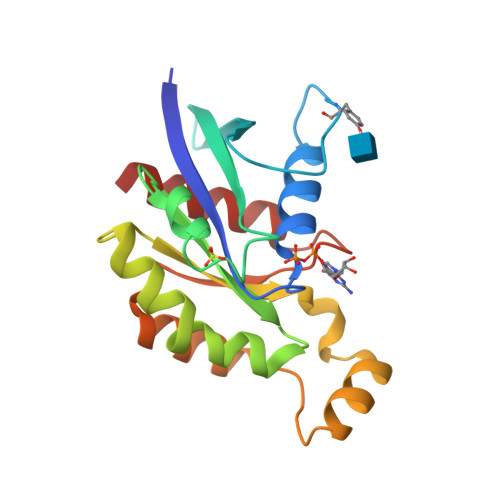Tyrosine glycosylation of Rho by Yersinia toxin impairs blastomere cell behaviour in zebrafish embryos.
Jank, T., Eckerle, S., Steinemann, M., Trillhaase, C., Schimpl, M., Wiese, S., van Aalten, D.M., Driever, W., Aktories, K.(2015) Nat Commun 6: 7807-7807
- PubMed: 26190758
- DOI: https://doi.org/10.1038/ncomms8807
- Primary Citation of Related Structures:
5A0F - PubMed Abstract:
Yersinia species cause zoonotic infections, including enterocolitis and plague. Here we studied Yersinia ruckeri antifeeding prophage 18 (Afp18), the toxin component of the phage tail-derived protein translocation system Afp, which causes enteric redmouth disease in salmonid fish species. Here we show that microinjection of the glycosyltransferase domain Afp18(G) into zebrafish embryos blocks cytokinesis, actin-dependent motility and cell blebbing, eventually abrogating gastrulation. In zebrafish ZF4 cells, Afp18(G) depolymerizes actin stress fibres by mono-O-GlcNAcylation of RhoA at tyrosine-34; thereby Afp18(G) inhibits RhoA activation by guanine nucleotide exchange factors, and blocks RhoA, but not Rac and Cdc42 downstream signalling. The crystal structure of tyrosine-GlcNAcylated RhoA reveals an open conformation of the effector loop distinct from recently described structures of GDP- or GTP-bound RhoA. Unravelling of the molecular mechanism of the toxin component Afp18 as glycosyltransferase opens new perspectives in studies of phage tail-derived protein translocation systems, which are preserved from archaea to human pathogenic prokaryotes.
Organizational Affiliation:
Institute of Experimental and Clinical Pharmacology and Toxicology, Albert-Ludwigs-University Freiburg, D-79104 Freiburg, Germany.





















